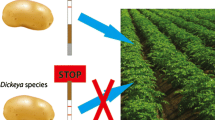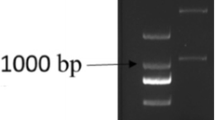Summary
An indirect sandwich enzyme-linked immunosorbent assay (ELISA) was used to monitor potato stems of three cultivars for the presence of the ring rot pathogen,Clavibacter michiganensis subsp.sepedonicus, during the growing season and in progeny tubers after harvest. The highest ELISA values were obtained with the highest concentration of bacteria used to inoculate seed pieces in all cultivars tested. Low ELISA values were obtained for stems and progeny tubers selected from plants grown from seed inoculated at lower bacterial concentrations. Estimates of bacterial densities in stems and progeny tubers by immunofluorescence indicated that low ELISA values were most probably caused by low bacterial numbers. It is suggested that the sensitivity of ELISA for detecting the ring rot pathogen in potato stems and progeny tubers is a function of the concentration of bacteria in individual seed pieces.
Similar content being viewed by others
References
Anonymous, 1987. Scheme for the detection and diagnosis of the ring rot bacteriumCorynebacterium sepedonicum in batches of potato tubers. EUR 11288. Office for Official Publications of the European Communities, Luxembourg, 21 pp.
Barton-Willis, P.A., P.D. Roberts, A. Guo & J.E. Leach, 1989. Growth dynamics ofXanthomonas campestris pv.oryzae in leaves of rice differential cultivars.Phytopathology 79: 573–578.
Bishop, A.L. & S.A. Slack, 1987. Effect of cultivar, inoculum dose, and strain ofClavibacter michiganense subsp.sepedonicum on symptom development in potatoes.Phytopathology 77: 1085–1089.
Corbière, R., L. Hingand & B. Jouan, 1987. Application des méthodes ELISA et immunofluorescence pour la détection deCorynebacterium sepedonicum: réponses variétales de la pomme de terre au flétrissement bactérien.Potato Research 30: 539–549.
De Boer, S.H. & R.J. Copeman, 1980. Bacterial ring rot testing with the indirect fluorescent antibody staining procedure.American Potato Journal 57: 457–465.
De Boer, S.H. & J.W. Hall, 1988. An automated microscope system for estimating the population ofCorynebacterium sepedonicum cells labelled with monoclonal antibodies in immunofluorescence.Canadian Journal of Microbiology 10: 215–220.
De Boer, S.H. & M. McCann, 1989. Determination of population densities ofCorynebacterium sepedonicum in potato stems during the growing season.Phytopathology 79: 946–951.
De Boer, S.H. & M. McCann 1990. Detection ofCorynebacterium sepedonicum in potato cultivars with different propensities to express ring rot symptoms.American Potato Journal 67: 685–694.
De Boer, S.H. & M.E. McNaughton, 1986. Evaluation of immunofluorescence with monoclonal antibodies for detecting latent bacterial ring rot infections.American Potato Journal 63: 533–543.
De Boer, S.H., A. Wieczorek & A. Kummer, 1988. An ELISA test for bacterial ring rot of potato with a new monoclonal antibody.Plant Disease 72: 874–878.
De Boer, S.H., T.-L. De Haan & J. Mawhinney, 1989. Predictive value of postharvest serological tests for bacterial ring rot of potato.Canadian Journal of Plant Pathology 11: 317–321.
De Boer, S.H., J. Van Vaerenbergh, D. Stead, J.D. Janse & A.R. McKenzie, 1992. A comparative study in five laboratories on detection ofClavibacter michiganensis subsp.sepedonicus in potato stems and tubers.Potato Research 35: 217–226.
Gudmestad, N.C., D. Baer & C.J. Kurowski, 1991. Validating immunoassay test performance in the detection ofCorynebacterium sepedonicum during the growing season.Phytopathology 81: 475–480.
Manzer, F.E. & A.R. McKenzie, 1988. Cultivar response to bacterial ring rot infection in Maine.American Potato Journal 23: 333–339.
Nelson, G.A., 1982.Corynebacterium sepedonicum in potato: effect of inoculum concentration on ring rot symptoms and latent infections.Canadian Journal of Plant Pathology 4: 129–133.
Sletten, A., 1985. The effect ofCorynebacterium sepedonicum on symptoms and yield of four potato cultivars.Potato Research 28: 27–33.
Sutula, C.L., J.M. Gillett, S.M. Morrissey & D.C. Ramsdell, 1986. Interpreting ELISA data and establishing the positive-negative threshold.Plant Disease 70: 722–726.
Author information
Authors and Affiliations
Rights and permissions
About this article
Cite this article
De Boer, S.H., Janse, J.D., Stead, D.E. et al. Detection ofClavibacter michiganensis subsp.sepedonicus in potato stems and tubers grown from seed pieces with various levels of inoculum. Potato Res 35, 207–216 (1992). https://doi.org/10.1007/BF02357617
Accepted:
Issue Date:
DOI: https://doi.org/10.1007/BF02357617




